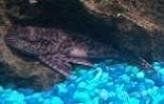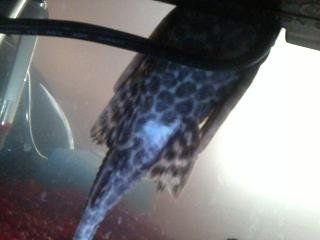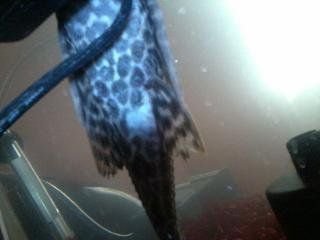I noticed last night that my largest pleco has a large whiteish almost clear spot on his head. Until yesterday I did not notice any afflictions or odd behavior. He still seems to be acting normal this morning, swimming about as much as he normally does and the food I dropped in before going to bed is gone. However I fear this may be a columnaris infection but wanted to get the opinions of some more experienced before I started any kind of treatment. I've kept fish years ago but just recently got back into it about three months ago, the Pleco in question is housed in a 120gallon tank I got second hand a little over a month ago. It is lightly planted and because all rocks (new gravel) and filter was used in an established aquarium it seems to have cycled pretty quickly. I tested for ammonia yesterday and it was <0.25ppm and while I don't have a nitrate test kit at home I had the water tested at the LFS two weeks ago and they said it was 0. I will take another sample later today. Since this appeared so suddenly I am wondering if it is just an injury and not something to get so worried about. I know he lays under lava rocks, sometimes under ones he really can not fit under so perhaps he scraped himself. If it is just an injury what can I do to aid in healing? The pleco is almost 8 inches long, and if I do need to treat him the only hospital tank I have is a small 10 gallon, is that going to be acceptable since its only temporary or should I get at least a 20?
Tank size: 120 Gallon
pH: N/A
ammonia: <0.25
nitrite: 0 (As of two weeks ago)
nitrate: 0 (As of two weeks ago)
kH: N/A
gH: N/A
tank temp: 78F
Fish Symptoms: Whiteish/pinkish/clear lesion on head, seems to still be eating and swimming as normal, just noticed it yesterday when I was feeding fish before bed. No other fish affected as far as I can tell.
Volume and Frequency of water changes: 10% weekly
Chemical Additives or Media in your tank: Added API Stress Zyme and Seachem Clarity water clarifier one week before adding fish, added Jungle Start Zyme one day before adding fish, washed filter media often during the first week as the well water is nasty and the clarifier gunked the filter bad. Nothing added since I placed fish in tank.
Tank inhabitants: Angels, Mollies, Clown Loaches, Plecos, Mystery Snails, Various live plants, Natural and artificial rocks
Recent additions to your tank (living or decoration): Added 5 small angels and 3 small clown loaches and about 10 aquarium plant bulbs 48h ago (36h before I noticed symptoms)
Exposure to chemicals: See above
Tank size: 120 Gallon
pH: N/A
ammonia: <0.25
nitrite: 0 (As of two weeks ago)
nitrate: 0 (As of two weeks ago)
kH: N/A
gH: N/A
tank temp: 78F
Fish Symptoms: Whiteish/pinkish/clear lesion on head, seems to still be eating and swimming as normal, just noticed it yesterday when I was feeding fish before bed. No other fish affected as far as I can tell.
Volume and Frequency of water changes: 10% weekly
Chemical Additives or Media in your tank: Added API Stress Zyme and Seachem Clarity water clarifier one week before adding fish, added Jungle Start Zyme one day before adding fish, washed filter media often during the first week as the well water is nasty and the clarifier gunked the filter bad. Nothing added since I placed fish in tank.
Tank inhabitants: Angels, Mollies, Clown Loaches, Plecos, Mystery Snails, Various live plants, Natural and artificial rocks
Recent additions to your tank (living or decoration): Added 5 small angels and 3 small clown loaches and about 10 aquarium plant bulbs 48h ago (36h before I noticed symptoms)
Exposure to chemicals: See above





